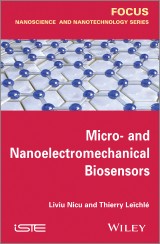Details

Micro-and Nanoelectromechanical Biosensors
1. Aufl.
|
139,99 € |
|
| Verlag: | Wiley |
| Format: | |
| Veröffentl.: | 17.01.2014 |
| ISBN/EAN: | 9781118760987 |
| Sprache: | englisch |
| Anzahl Seiten: | 144 |
DRM-geschütztes eBook, Sie benötigen z.B. Adobe Digital Editions und eine Adobe ID zum Lesen.
Beschreibungen
<p>Most books dedicated to the issues of bio-sensing are organized by the well-known scheme of a biosensor. In this book, the authors have deliberately decided to break away from the conventional way of treating biosensing research by uniquely addressing biomolecule immobilization methods on a solid surface, fluidics issues and biosensing-related transduction techniques, rather than focusing simply on the biosensor. The aim is to provide a contemporary snapshot of the biosensing landscape without neglecting the seminal references or products where needed, following the downscaling (from the micro- to the nanoscale) of biosensors and their respective best known applications. To conclude, a brief overview of the most popularized nanodevices applied to biology is given, before comparing biosensor criteria in terms of targeted applications.</p>
<p>INTRODUCTION vii</p> <p><b>CHAPTER 1. TRANSDUCTION TECHNIQUES FOR MINIATURIZED BIOSENSORS 1</b></p> <p>1.1. Definition of bioMEMS 1</p> <p>1.2. Transduction techniques 2</p> <p>1.2.1. Optical transduction 2</p> <p>1.2.2. Electro (chemical) transduction 6</p> <p>1.2.3. Mechanical transduction 10</p> <p>1.3. MEMS transducers 17</p> <p>1.4. One specific application of MEMS biosensors: detection of pathogen agents 20</p> <p>1.5. Bibliography 25</p> <p><b>CHAPTER 2. BIORECEPTORS AND GRAFTING METHODS 35</b></p> <p>2.1. Types of bioreceptor 35</p> <p>2.1.1. Catalytic receptors 36</p> <p>2.1.2. Affinity receptors 37</p> <p>2.1.3. Nucleic acid-based receptors 40</p> <p>2.1.4. Molecularly imprinted polymers 41</p> <p>2.2. Immobilization strategies 43</p> <p>2.2.1. Adsorption and antifouling strategies 44</p> <p>2.2.2. Entrapment methods 49</p> <p>2.2.3. Covalent coupling 51</p> <p>2.2.4. Other capture systems 54</p> <p>2.2.5. Immobilization strategies: summary 56</p> <p>2.3. Conclusion 57</p> <p>2.4. Bibliography 57</p> <p><b>CHAPTER 3. PATTERNING TECHNIQUES FOR THE BIOFUNCTIONALIZATION OF MEMS 65</b></p> <p>3.1. What is surface patterning? 65</p> <p>3.2. Direct biopatterning in liquid phase 66</p> <p>3.2.1. Ink delivery by non-contact methods 67</p> <p>3.2.2. Ink delivery by contact methods 71</p> <p>3.3. Replication of patterns 80</p> <p>3.3.1. Photolithography 81</p> <p>3.3.2. Light-induced patterning strategies 81</p> <p>3.3.3. Microcontact printing 82</p> <p>3.3.4. In-flux functionalization 83</p> <p>3.4. Conclusions 84</p> <p>3.5. Bibliography 85</p> <p><b>CHAPTER 4. FROM MEMS TO NEMS BIOSENSORS 93</b></p> <p>4.1. Importance of downscaling 93</p> <p>4.2. Challenges faced by NEMS for biosensing applications 95</p> <p>4.2.1. Issues related to nanomechanical transducers 97</p> <p>4.2.2. Issues related to the functionalization of NEMS 99</p> <p>4.2.3. On the importance of packaging and sample preparation 103</p> <p>4.3. Economic considerations 106</p> <p>4.4. Bibliography 107</p> <p><b>CHAPTER 5. COMPARING PERFORMANCES OF BIOSENSORS: IMPOSSIBLE MISSION? 113</b></p> <p>5.1. Bibliography 117</p> <p>INDEX 119</p>
<p><strong>Thierry Leïchlé</strong> is a CNRS researcher at the Laboratory for Analysis and Architecture of Systems in Toulouse, France. <p><strong>Liviu Nicu</strong> is a full time CNRS (National Center of Scientific Research) researcher the NanoBioSytems Group at LAAS in Toulouse, France.


















